A foam roller is an effective tool for muscle recovery, providing self-myofascial release that alleviates tightness and soreness. By enhancing blood flow and promoting relaxation, foam rolling aids in pain relief and improves overall mobility. Regular use can also enhance flexibility, helping to break down muscle knots and increase range of motion for better movement and performance.
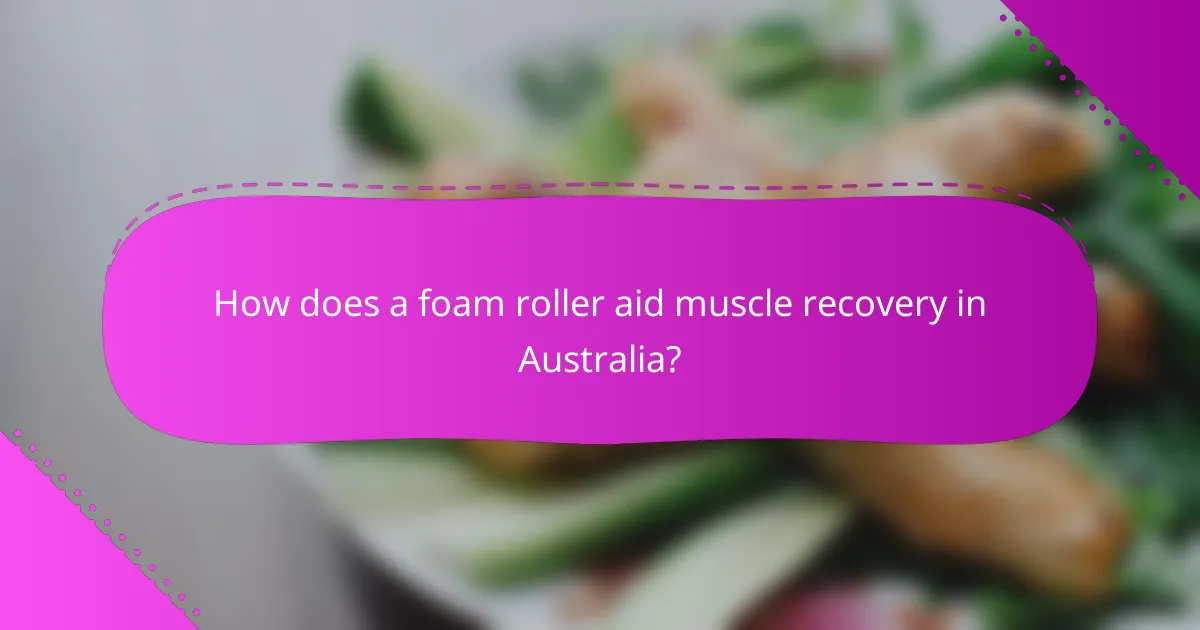
How does a foam roller aid muscle recovery in Australia?
A foam roller aids muscle recovery in Australia by providing a form of self-myofascial release that helps alleviate muscle tightness and soreness. This technique promotes relaxation and enhances overall recovery after physical activity.
Reduces muscle soreness
Using a foam roller can significantly reduce muscle soreness, especially after intense workouts. By applying pressure to specific muscle groups, it helps break down knots and tightness, which can lead to a decrease in delayed onset muscle soreness (DOMS).
To effectively reduce soreness, spend about 1-2 minutes rolling each muscle group, focusing on areas that feel particularly tight. This practice can be especially beneficial after high-impact sports or strength training sessions.
Improves blood circulation
Foam rolling enhances blood circulation, which is crucial for muscle recovery. Increased blood flow delivers more oxygen and nutrients to the muscles, aiding in the repair process and reducing recovery time.
For optimal results, incorporate foam rolling into your post-workout routine. Aim for a session of 10-15 minutes, targeting major muscle groups like the quads, hamstrings, and back to maximize circulation benefits.
Enhances range of motion
Regular use of a foam roller can improve your range of motion, making it easier to perform exercises and daily activities. By loosening tight muscles and fascia, foam rolling helps increase flexibility and mobility.
To enhance your range of motion, include foam rolling as part of your warm-up or cool-down routine. Spend time on areas like the calves and hips, which are often tight, to promote better movement patterns and reduce injury risk.

What are the benefits of foam rolling for pain relief?
Foam rolling offers several benefits for pain relief, primarily by enhancing blood flow and reducing muscle tightness. This self-massage technique can help alleviate discomfort and improve overall mobility, making it a valuable tool for athletes and anyone experiencing muscle soreness.
Alleviates tension in muscles
Foam rolling effectively alleviates tension in muscles by applying pressure to tight areas, promoting relaxation and recovery. Regular use can help reduce stiffness and improve flexibility, making it easier to perform daily activities or engage in physical exercise.
To maximize the benefits, focus on rolling over major muscle groups such as the quadriceps, hamstrings, and back. Aim for 1-2 minutes per muscle group, adjusting the pressure based on your comfort level.
Targets trigger points effectively
Foam rolling is particularly effective for targeting trigger points, which are tight knots in muscles that can cause pain and discomfort. By applying sustained pressure to these areas, you can help release tension and improve blood circulation, leading to pain relief.
When identifying trigger points, look for areas that feel particularly sensitive or painful when pressed. Spend extra time on these spots, but avoid rolling over bony areas or joints to prevent injury. A good rule of thumb is to hold pressure on a trigger point for 20-30 seconds before continuing to roll.
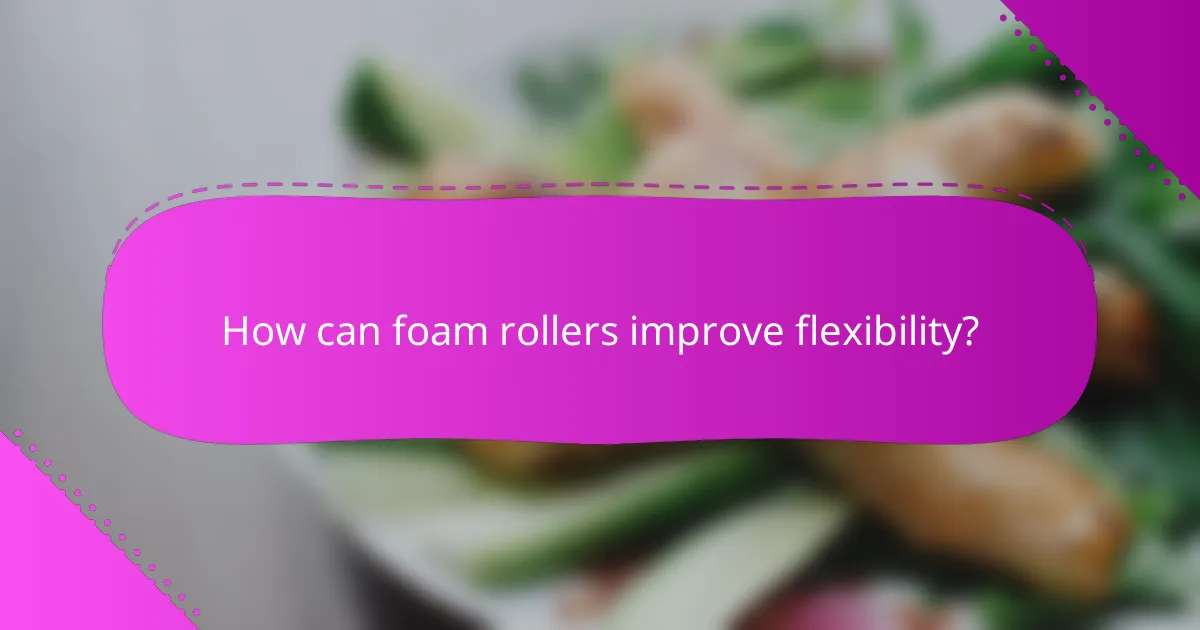
How can foam rollers improve flexibility?
Foam rollers enhance flexibility by promoting muscle relaxation and improving blood flow, which can lead to increased range of motion. Regular use can help break down muscle knots and tension, making it easier to stretch and move freely.
Increases muscle elasticity
Foam rolling helps increase muscle elasticity by applying pressure to tight areas, which can stimulate the fascia and surrounding tissues. This process encourages the muscles to lengthen and become more pliable, enhancing overall flexibility.
To maximize elasticity gains, focus on rolling each muscle group for about 30 seconds to 2 minutes, ensuring even coverage. Pay special attention to areas that feel particularly tight or sore, as these are often where flexibility is most restricted.
Facilitates dynamic stretching
Foam rollers can facilitate dynamic stretching by preparing muscles for movement through self-myofascial release. This technique helps to warm up muscles and improve circulation, making them more responsive during dynamic stretches.
Incorporate foam rolling into your warm-up routine before activities like running or sports. Spend a few minutes rolling out major muscle groups, then follow up with dynamic stretches such as leg swings or arm circles to further enhance flexibility and performance.
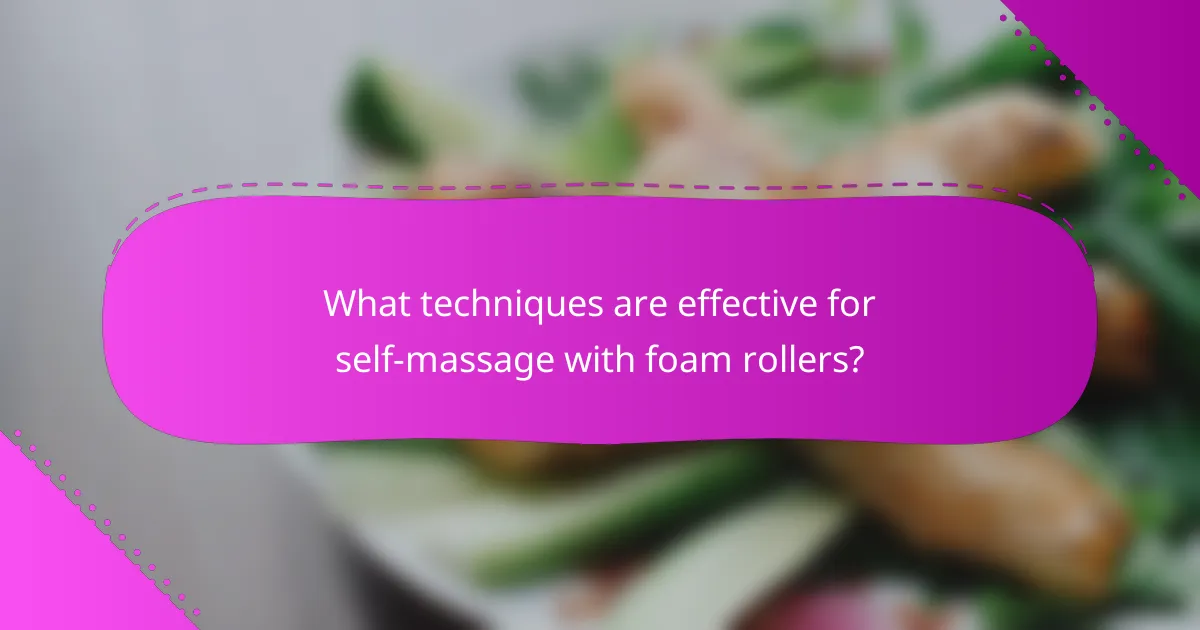
What techniques are effective for self-massage with foam rollers?
Effective self-massage techniques with foam rollers include longitudinal rolling and cross-friction techniques. These methods help alleviate muscle soreness, improve flexibility, and enhance recovery by applying targeted pressure to specific muscle groups.
Longitudinal rolling technique
The longitudinal rolling technique involves rolling the foam roller along the length of the muscle, typically from the origin to the insertion point. This method is effective for larger muscle groups like the quadriceps, hamstrings, and back. Aim to spend about 30 seconds to 1 minute on each muscle group, adjusting pressure as needed based on comfort.
To perform this technique, position the foam roller under the targeted muscle and slowly roll back and forth. Focus on areas that feel tight or sore, pausing briefly on tender spots to allow for deeper tissue release. Avoid rolling directly over joints or bony areas to prevent discomfort.
Cross-friction technique
The cross-friction technique targets specific muscle knots or trigger points by applying pressure perpendicular to the muscle fibers. This approach is particularly useful for smaller muscle groups, such as the calves or shoulders. Spend about 20 to 30 seconds on each knot, using a moderate amount of pressure.
To execute this technique, position the foam roller on the affected area and roll side to side, focusing on tight spots. You can adjust the angle of your body to better target specific areas. Be mindful of your body’s response; if you experience sharp pain, reduce the pressure or stop the technique.
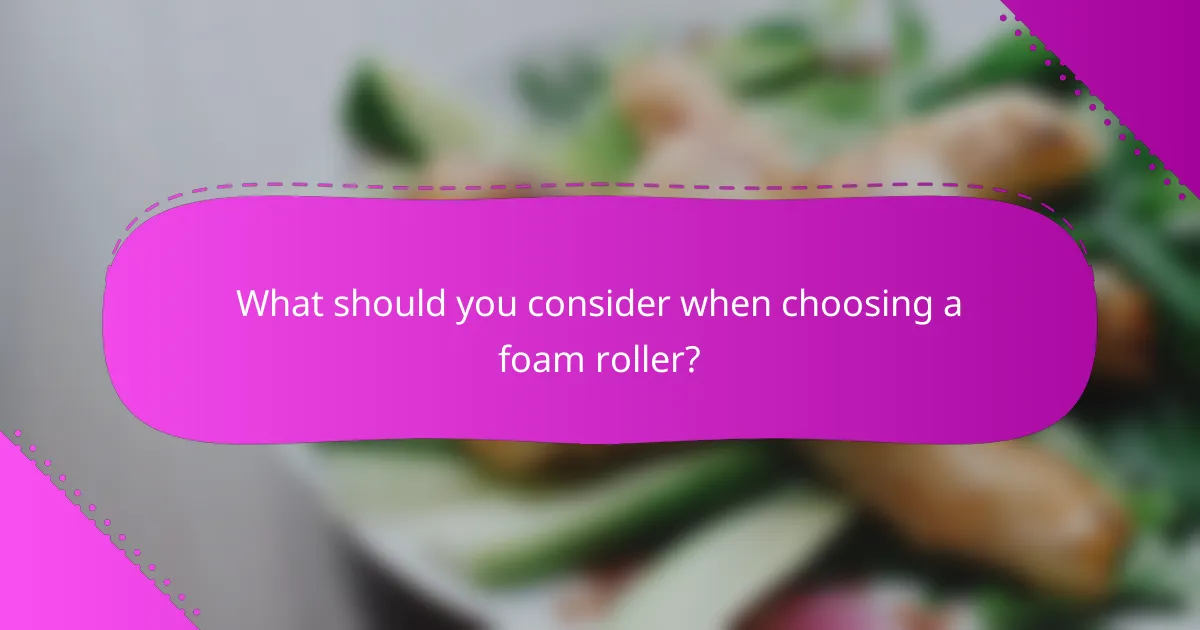
What should you consider when choosing a foam roller?
When selecting a foam roller, consider factors such as density, firmness, size, and shape to ensure it meets your muscle recovery, pain relief, and flexibility improvement needs. Choosing the right roller can enhance your self-massage experience and effectiveness.
Density and firmness
The density and firmness of a foam roller significantly affect its performance. Softer rollers are generally better for beginners or those with sensitive muscles, while firmer options provide deeper pressure for experienced users seeking intense muscle relief.
Consider your specific needs: if you are recovering from an injury, a softer roller may be more appropriate, while athletes may prefer a firmer roller to target tight muscles effectively. Test different densities to find what feels best for your body.
Size and shape
Foam rollers come in various sizes and shapes, each serving different purposes. Standard rollers are typically around 36 inches long and 6 inches in diameter, suitable for most users. However, shorter rollers can be more portable and easier to store.
Shape also matters; some rollers feature grooves or bumps designed to mimic a massage therapist’s hands, which can enhance the self-massage experience. Choose a size and shape that aligns with your intended use, whether for full-body rolling or targeting specific muscle groups.
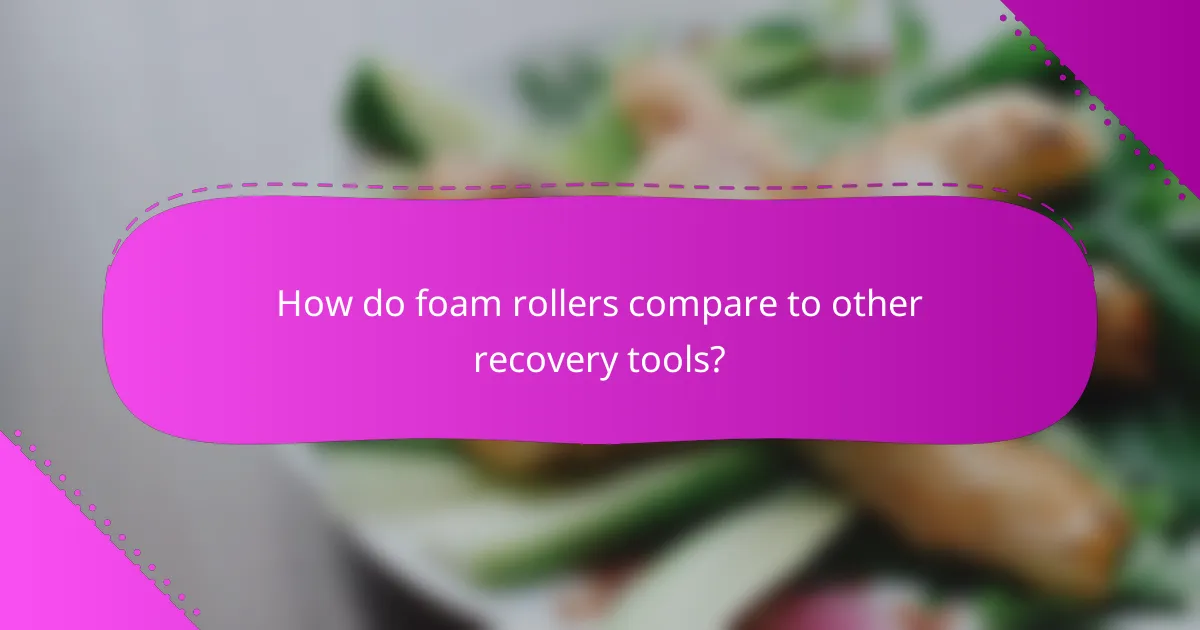
How do foam rollers compare to other recovery tools?
Foam rollers are a popular choice for muscle recovery, pain relief, and flexibility improvement, often compared to other recovery tools like massage guns and stretching bands. Each tool has unique benefits and applications, making it important to understand their differences to choose the right one for your needs.
Foam roller vs massage gun
Foam rollers and massage guns serve similar purposes but operate differently. Foam rollers provide a broader, more even pressure across larger muscle groups, making them effective for self-myofascial release. In contrast, massage guns deliver targeted, pulsating pressure to specific areas, which can be beneficial for deep tissue work.
When deciding between the two, consider your goals. Foam rollers are ideal for general muscle recovery and flexibility, while massage guns excel in providing quick relief for tight spots. Both tools can be used together for a comprehensive recovery routine.
Foam roller vs stretching bands
Foam rollers focus on muscle recovery through self-massage, while stretching bands are primarily used for enhancing flexibility and strength. Stretching bands allow for resistance training and dynamic stretching, which can complement the benefits of foam rolling by improving range of motion.
To maximize recovery, incorporate both tools into your routine. Use a foam roller to alleviate muscle tension and follow up with stretching bands to enhance flexibility. This combination can help prevent injuries and improve overall performance in physical activities.

What are the best foam roller brands available in Australia?
Some of the best foam roller brands available in Australia include TriggerPoint, ProForm, and Liforme. These brands are known for their quality, durability, and effectiveness in aiding muscle recovery, pain relief, and flexibility improvement.
TriggerPoint
TriggerPoint foam rollers are popular among athletes and fitness enthusiasts for their innovative design and effectiveness. They often feature textured surfaces that provide targeted pressure to sore muscles, enhancing self-massage techniques. Prices typically range from AUD 30 to AUD 100, depending on the model and features.
ProForm
ProForm offers a variety of foam rollers that cater to different needs, including high-density options for deeper tissue massage. Their rollers are designed to improve flexibility and reduce muscle soreness post-workout. Expect to pay between AUD 25 and AUD 80 for ProForm products.
Liforme
Liforme is known for its eco-friendly foam rollers that combine sustainability with performance. Their rollers are designed to support muscle recovery and enhance flexibility, making them a great choice for yoga practitioners and athletes alike. Prices generally range from AUD 40 to AUD 90.
